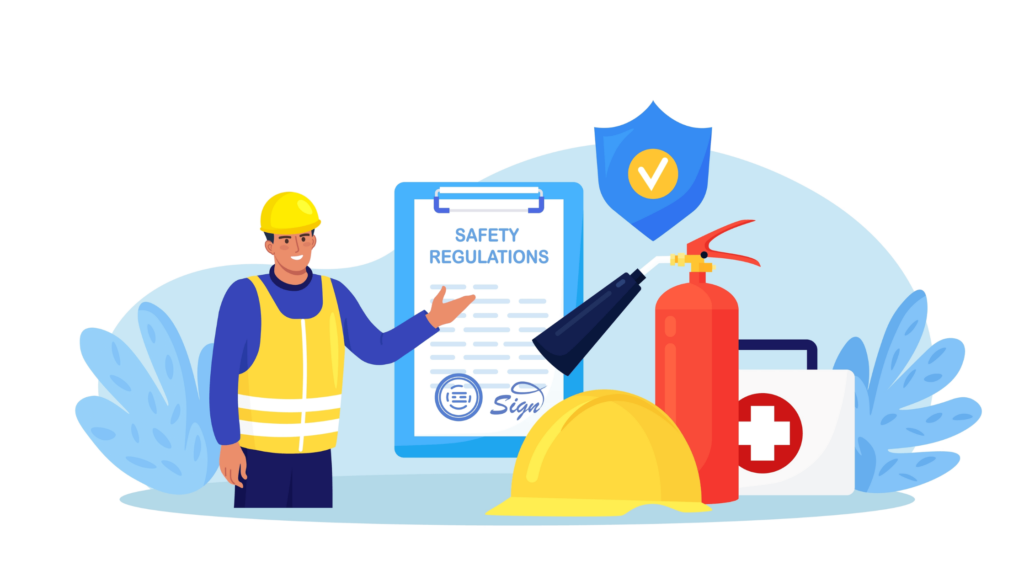The Occupational Safety and Health Administration (OSHA) is seeing another increase in penalties for safety violations in 2025. Increases are determined based on inflation and cost of living, and construction companies are penalized per violation and for each day the employer fails to abate the previously cited violation. Top violations include respiratory protection, ladder violations, and fall protection violations.
2024 top OSHA violations

10. Machine guarding
Standard number: 1910.212
Number of violations: 1,541
Machine guarding refers to violations related to unsafe practices with machine parts. Moving machine parts could potentially cause serious injuries or fatalities. Injuries could include amputations, burns, blindness, and crushed hands or fingers.
To protect workers, it’s important to implement safeguards. Any machine function, process, or part that may cause harm must be safeguarded. When the operation or accidental contact of the machine causes injury to anyone in the vicinity, including the operator, those hazards must be controlled or eliminated. Failure to implement these safeguards or controls results in violations.
9. Personal protective and lifesaving equipment
Standard number: 1926.102
Number of violations: 1,814
Personal protective equipment (PPE) includes clothing for the face, eyes, and head and protection for the extremities. Examples of types of protection include protective face shields, respiratory devices, and clothing barriers for chemical, mechanical, radiological, and other environmental hazards in the workplace.
If employers fail to provide or require employees to use PPE, it could result in an OSHA violation. This PPE must meet the specifications for design as stated in the National Institute of Occupational Safety and Health (NIOSH) or the American National Standards Institute (ANSI). Employers are responsible for properly maintaining PPE, including employee-owned equipment.
8. Scaffolding
Standard number: 1926.451
Number of violations: 1,873
OSHA mandates that scaffolds must be constructed, designed, and erected by qualified workers. This includes ensuring the scaffold structure can support at least four times the maximum intended load. Failure to assemble scaffolding that does not meet these requirements results in violations.
7. Fall protection – training requirements
Standard number: 1926.503
Number of violations: 2,050
To avoid fall protection violations, OSHA requires employers to keep work areas’ floors clean and dry. They must also select and provide required PPE at no cost to employees, adequately train workers about job hazards in a language they can understand, and provide working conditions free of known fall dangers.
6. Powered industrial trucks
Standard number: 1910.178
Number of violations: 2,248
Reasons for OSHA violations for powered industrial trucks could include a lack of adequate operator training, failing to perform routine inspections on the truck, operating the vehicle unsafely, overloading the truck, and not removing a defective truck from service. Failure to maintain the truck properly could also result in a penalty.
5. Lockout/tagout
Standard number: 1910.147
Number of violations: 2,443
Lockout and tagout (LOTO) violations can occur for several reasons. The most frequently occurring examples are failure to identify and isolate energy sources, train employees, and establish a proper LOTO program.
Failing to conduct LOTO inspections and follow procedures and unauthorized LOTO operations may also result in penalties.
4. Respiratory protection
Standard number: 1910.134
Number of violations: 2,470
Employers must provide respirators, proper training, and regular medical evaluations at no charge to employees. They must also follow proper respirator selection guidelines, which means a routine respiratory hazard evaluation must be conducted at each site.
Identifying relevant workplace and respirator user factors and basing respirator selection on these factors is also mandatory.
3. Ladder
Standard number: 1926.1053
Number of violations: 2,573
Ladder is another larger OSHA violation category, and violations can be broken up into distinct categories.
Improper setup, inadequate maintenance, using the wrong ladder, and using a defective ladder are common ways employers receive OSHA penalties. Lack of fall protection, inadequate safety training, moving a ladder while in use, and using a wet, oily, or greasy ladder will also result in violations.
2. Hazard communication
Standard number: 1910.1200
Number of violations: 2,888
Hazard communication violations occur when employers fail to inform workers about hazardous chemicals in the workplace. Lack of notification includes not producing a written hazard communication program, failing to provide adequate chemical training, not labeling containers, or not maintaining Safety Data Sheets for each present chemical on site.
1. Fall protection
Standard number: 1926.501
Number of violations: 6,307
Fall protection violations have long been number one on the list, and according to OSHA, a violation occurs when employers fail to provide necessary fall protection equipment or systems for working at heights.
This includes scenarios like elevated surfaces, unprotected edges, holes in floors, or open-sided platforms without safety nets, guardrails, or personal fall arrest systems. Failing to provide adequate fall protection training on proper equipment use and hazard identification also results in penalties.
What’s changed with penalties?
As of January 15th, 2025, OSHA’s maximum violation penalties have increased. Violations were previously $16,131 and are now $16,550 for each serious and other-than-serious violation. The penalty also applies for each day the employer fails to abate the previously cited infraction.
Penalties for repeated or willful violations have also been raised from $161,323 to $165,514 per violation. This annual increase of roughly 2.6% between 2024 and 2025 is a decrease from the 3.2% climb from 2023 to 2024.
According to the federal government, the increase in violations is correlated with the annual cost-of-living increases and inflation. Increased violations could inspire more stringent safety protocols and fewer violations, but that statistic also depends on increased safety measures’ effectiveness. Improved safety hazard culture and fewer violations can only be achieved when organizations commit to changing or overhauling their processes.
Bottom line
OSHA violations are a significant motivator for construction companies to implement and maintain proper safety protocols in the workplace. While injuries and fatalities are always possible, with or without OSHA, the risk of high costs due to preventable violations does reduce the number of incidents significantly.
Ladder and hazard communication violations are among the most prominent violations OSHA has seen, but fall protection violations once again top the list. In theory, increasing violation penalties should reduce incidents further, but an impactful change would require a more drastic cultural shift regarding workplace safety.
Like this and want more content like it? Subscribe to our weekly newsletter and follow us on social media to stay up to date with the latest construction safety news.


